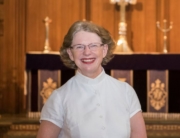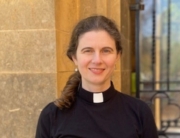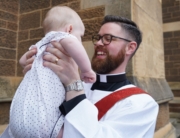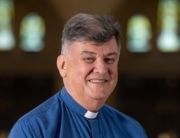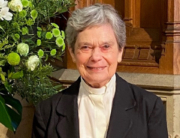Rev Dr Lynn Arnold AO
Morning Sermon
30 September 2018
Secular the little children
May the words of my mouth and the meditations of our hearts be worthy in your sight, O Lord, our Rock and our Redeemer. Amen.
Our reading from Mark this morning carried this portentous statement:
If any of you put a stumbling-block before one of these little ones who believe in me, it would be better for you if a great millstone were hung around your neck and you were thrown into the sea. [9:42]
This verse comes five verses after those which the Dean preached about last Sunday:
And Jesus took a child and put him in the midst of them, and taking him in his arms, he said to them, whoever receives one such child in my name receives me, and whoever receives me, receives not me but him who sent me. [Mark 9:36-37]
So it is upon the theme of Jesus’ call to us relating to children that I wish to preach this morning. At the outset, let me acknowledge that the child of last week’s verses – παιδίον [paidion – young child] – is not the same as the little one of this week’s – μικρόν [mikron – little one]. But the two concepts are similar in a meaningful way that permits me to focus on the children among the mikron of today’s reading.
One of the community roles I undertake is to be Patron of the Schools Ministry Group which provides chaplaincy services in about three hundred and fifty public schools in South Australia. Prior to this current role, I had been chair of the SMG board for three years. Just this last week, I had the pleasure of participating in part of SMG’s annual get-together of all the chaplains (or pastoral care workers as they are officially known), SMG staff and representatives from many of the ninety or so support groups around the state that provide financial support to this ministry. It was an occasion of unalloyed and joyous enthusiasm, as the group shared experiences, listened to specialist speakers on themes related to their work and spent time in spiritually-nourishing prayer and worship.
I mentioned that there are nearly a hundred support groups around the state who raise money for the work of the pastoral care workers. But the substantial part of the funding of this work comes from the federal government under the National School Chaplaincy program. In the 2018 federal budget, this program was renewed for a further four years. However, this federal support is not without its opponents.
A couple of years ago I was interviewed by Ian Henschke on his morning program on ABC 891. It was intended to be a general interest interview, but Ian started on the subject of government funding for school chaplaincy services as he had heard about my role with SMG. The tenor of his interview was probing but not antagonistic. However, after the interview was finished, his producer told me that the studio switchboard had lit up with incoming calls whilst we were discussing the subject … and, she told me, all the callers had opposed the idea of government funding for such chaplaincy services. She had taken the trouble to point this out to me as she had seldom seen such a quick and strong negative reaction to a topic aired on that program.
I was somewhat taken aback. Not at the thought of having opposition to something I might have said – I’m used to that. But at the fact that government funding for chaplaincy should evoke such outrage. It was not that I didn’t know about there being such opposition but the size and vehemence that had erupted on this occasion was unexpected. Somehow, perhaps naively, I had thought that there would be general support for services aimed at helping young people in times of stress.
I was certainly aware that there were opponents of the program. Some months previously Ian Henschke had asked me for my opinion about a then recently published book – “Sacred to Secular: Why a corrupted Christianity demands a Secular solution”. This polemical work had been written by Adelaide writer, Brian Morris. The book was, in my opinion, an unmitigated diatribe. Not unsurprisingly, Morris had negative things to say about the school chaplaincy program including this nugget:
Chaplains in schools was an ill-conceived thought-bubble from day one … (money) has been wasted on a half-baked scheme of unqualified Christians masquerading as school counsellors. In recent years the system has been effectively hijacked by evangelical organisations. [p55]
He further posited that chaplains were ‘incompatible with secular education’, further labelling them as ‘unskilled … (as well as) unqualified’, saying that: [p56]
The mere presence of chaplains reinforces an invasive one-denominational Christian ethos.
These brief quotes contain so many inaccuracies as to what actually is the case, that I don’t have time now to set the record straight – suffice to say it can be and I’ll happily provide such information to anyone who wants it.
More seriously, however, is to understand the metanarrative at play here. The callers to Ian Henschke’s program and Brian Morris in his statements were defining the societal problem as being the threat to children through any hint of religious involvement in secular education. But, in holding this view, they were simply addressing the wrong problem. There is a contemporary trend to define ‘secular’ as meaning the absence of any religious voice; so that the goal of opponents is to deny the inclusivity of the term so that children may be protected from the supposed dangers of religion. But they miss the point. Our very own Michael Hewitson (in his book “How will our Children learn”) has noted that:
In 1875, when the South Australian Education Act for ‘free, compulsory and secular’ state schools was put in place, the Oxford Dictionary defined secular as ‘non-denominational’. [p29]
Even some more reasonable non-believers understand that ‘secular’ is not exclusionary. David Pollock, writing in the Guardian, gave such an open-minded view of secular society:
Objectors often allege that humanists and other secularists wish to drive the religious from the public square. Not so. How could we, when atheism or humanism are in law no less “religions or beliefs” than Islam or Christianity? If Christians were banned from the public square, so would be humanists and atheists.
The secular context should not be closed, but open; and less energy should be spent on excising faith from it than on understanding the contemporary realities which characterise that context.
It is in this sense that those who called in that day to complain were addressing the wrong problem. The fact is that, quite distinct from the confected threat supposedly represented by religion, there are very real societal problems which need addressing. Furthermore, if they could but raise their gaze from their anti-religious obsessions, then I am certain even those objectors would be as concerned about these real problems as any of us. These problems are outcomes of a post-modern worldview that threatens to change the understanding that children are divine gifts not mere commodities or consumers; and in consequence there is a malaise threatening the well-being of the young.
In 2010, Desmond Tutu, visiting UNICEF House in New York, said this about children in the contemporary world:
I am appalled at the things that we adults have done in turning the world into a hostile place for children.
At the time he said those words he was primarily concerned about such things as child soldiers, child labourers and children as sex slaves. But, beyond these abominations, the world can also be subtly hostile to children as well as overtly. Furthermore, there can be the passive hostility of indifference. Children in our own community are not invulnerable to the hazards arising from this hostility.
We know, of course, of specific groups of children in our midst who live in challenging circumstances. The Smith family reports that one in seven Australian children lives below the poverty line and that there will be longer term consequences arising from that impoverished start. For example, by age fifteen, these children will, on average be two to three years behind their age cohort in reading and mathematics; and they will be only two thirds as likely to finish Year 12. The poverty of their childhood will not just have been a poor start to life, it will likely mean poorer outcomes for most of them in adulthood.
Then there are those thousands of children in Australia who cannot stay with their natural born families. For a variety of reasons, this mass of children, which is currently growing in total number by about three thousand a year, have become refugees from their own homes and have had to seek extra-familial sanctuary elsewhere. On most recently available figures, 44% will end up staying with relatives, 42% with foster parents and the balance either living on their own or in residential care – with the latter sometimes meaning that some children will end up spending portions of their troubled childhood transiting in motel rooms.
A quarter of these children will have had to be evacuated from their families due to having suffered neglect; the remainder will have suffered active abuse of one form or another – emotional abuse (44.5%), physical abuse (18.3%) or sexual abuse (12.2%) in descending order of magnitude.
Notwithstanding the caring support offered by relatives or foster parents, perhaps it would not surprise you to learn that such children are much more likely to end up homeless when they become young adults. But the young don’t have to wait to grow up to be at risk of being without shelter. Consider for a moment the number of children in our Australian community who are categorised as homeless. Homelessness Australia has reported that of all those defined as being homeless in this country, 27% are aged under 18, with two thirds of that number being under 12.
Such figures should cause gut-wrenching compassion within us. ‘Something should be done about it’, I hear us all thinking. These children at risk certainly need more than our compassion, they need our help. We should take guidance from the letter of James in the New Testament, where we read:
Religion that is pure and undefiled before God the Father is this: to visit orphans and widows in their affliction [James 1:27]
But at the risk of being alarmist, let me provide some additional commentary on broader challenges confronting all society’s children, not just those at the margins. If we look behind the comfortable façade of our society, we may see that there is, to use Desmond Tutu’s phrase, a hostile world confronting our children.
In December last year, the ABC reported that Adelaide had become the ice capital of Australia. The news item noted the release of the 2017 report of National Wastewater Drug Monitoring Program on the monitoring of the sewage of fourteen million Australians – the effluence of affluence, so to speak. The story indicated that, compared to the national capital city daily average of 30 doses of ice usage per thousand people, Adelaide’s effluent revealed a figure of eighty. I find that figure horrendous, especially after doing the maths – 80 dosages of ice per day per thousand people, means that, at the time of the survey, there were 80,000 doses of ice being consumed daily here in Adelaide. With this as part of the backdrop, Archbishop Desmond Tutu’s reference to the hostile world facing children takes on another perspective; for that statistic must surely be considered an indicator of overall unwellness in our society.
Another indicator of that very unwellness comes from distorted perceptions about happiness. The secular chimera held out to society is of the possibility of being constantly happy; this has long beguiled but always disappoints. The result has been escalating rates of depression along with the tragic consequence of an epidemic of suicide; and the young have been particularly at risk. The Report on the second Australian Child and Adolescent Survey of Mental Health and Wellbeing undertaken in 2015 found that one in seven young people between the ages of four and seventeen experienced a mental health disorder; while the Youth Beyond Blue website reports that half of all lifetime cases of mental health disorders started by the age of fourteen, with three quarters by the age of twenty four. On the subject of suicide, the organisation Headspace reported that, in 2015, suicide was the leading cause of death of children between five and seventeen; while it was the cause of a third of the deaths of those 15-24, and a quarter of those 25-34. Death by suicide kills fifty per cent more young people than car accidents; and the rate in 2015 was twenty five percent higher than a decade earlier.
Facts and figures like those I have mentioned deeply disturb school communities; and it is why so many eagerly want pastoral care workers to address the real problems facing their children. For they know that without such help their children are at greater risk; quite the opposite to the contention of Brian Morris who labelled the National Schools Chaplaincy Program ‘a discredited scheme.’ [p56] No, Brian, it is not the scheme that is discredited but a society that sits idly by and watches so many of its young flailing and failing in the face of a hostile world.
Let me return to the gospel verse:
If any of you put a stumbling-block before one of these little ones who believe in me, it would be better for you if a great millstone were hung around your neck and you were thrown into the sea. [9:42]
This sentiment is echoed in the gospels of Matthew [18:6] and Luke [17:1-2]. In the context of the challenges facing the young in our society, how do we feel we should respond?
It is the normal pattern of life that each generation bequeaths an inheritance to the next. What inheritance will our society bequeath our children? Will ours be a generation which encourages the next to seek hope with substance or leave many of them floundering in the depths of despair. I don’t believe it is overstating the case to say that this generation of children growing up face far more serious problems than you or I did in our youth. That morning of the radio program, all those callers saw non-proselytising pastoral care workers as the most serious threat facing our children in this city, the ice capital of the country. What say we?

